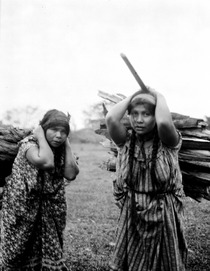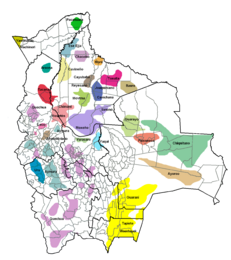Cavineño people facts for kids

Two women carrying firewood. Photo by Erland Nordenskiöld 1913-1914.
|
|
| Total population | |
|---|---|
| 3884 (2012) in |
|
| Languages | |
| Cavineña language, Spanish | |
| Religion | |
| Roman Catholicism (often syncretic with indigenous beliefs) | |
| Related ethnic groups | |
| Araona, Tacana, Ese Ejja |
The Cavineño people are an ethnic group living in Bolivia. They mostly live near the Beni and Madidi rivers. In 2012, there were about 3,884 Cavineño people. Many of them speak the Cavineña language, and almost all also speak Spanish. They are closely related to other groups who speak Takanan languages, like the Araona people.
Contents
Where the Cavineño Live
The Cavineño people mainly live in Bolivia. Their homes are found along the Beni and Madidi rivers. In 2012, there were 3,884 Cavineño people.
Languages Spoken
The Cavineño people speak two main languages. One is their own language, called Cavineña language. The other is Spanish, which almost all of them speak.
A Look at Cavineño History
The Cavineño people have a long history. In the late 1700s, they moved from the Madre de Dios River to the Madidi River.
Challenges in the Past
During the late 1800s, there was a time called the "rubber fever." Many people, including the Cavineño, had to work in very difficult conditions collecting rubber. Later, some Cavineño settled at a missionary station near the Beni River.
Population Changes Over Time
The number of Cavineño people changed over the years. In 1832, there were about 1,000 Cavineño. By 1886, this number had dropped to 153. Later, in 1913, explorer Erland Nordenskiöld counted 218 Cavineño at a mission called Jesus de Cavina.
Cavineño Communities Today
Today, the Cavineño people live in six small communities. These communities are in the areas of Riberalta and Reyes in Beni. Some also live in the Pando region.
Puerto Cavinas: A Main Community
The largest community for the Cavineño people is called Puerto Cavinas. It is an important place for them.
The Cavineño people own land together with other groups. They share their lands with the Tacanas in Beni. In Pando, they share land with both the Ese Ejja and the Tacanas.
See also
 In Spanish: Cavineños para niños
In Spanish: Cavineños para niños


